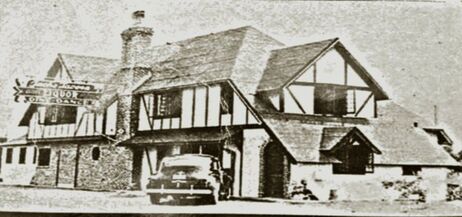 By M.P. Pellicer | Stranger Than Fiction Stories Ethel Allen disappeared, and eventually many believed justice failed her, but justice can be served in many ways.  Jack's Tavern opened in Rockledge, Florida in 1933 Jack's Tavern opened in Rockledge, Florida in 1933 The Volstead Act was repealed in 1933. The production of illegal alcohol, and the money tied into the vices found in speakeasies still flowed through the backwaters and scrub hammocks of Central Florida. A raid on the Blind Tiger, a pool room in Rockledge yielded 12 gallons of moonshine and case liquor. Authorities found more 160 proof hooch at the owner's house. In the early 1930s, Jack C. Allen came from Pennsylvania and opened a vending machine business named Allen's Amusements. He invested in a gasoline filling station, and built a small restaurant at a lonely place on Dixie Highway that skirted Florida's east coast through Rockledge. The land was just a ditch that was filled in. It sat next to the FEC tracks, and the building would shake every time a train thundered by. Then in December 1933, with the end of Prohibition he decided to expand and created Jack's Tavern, a two-story eatery where he served liquor, played music on the jukebox, and served locals and travelers alike. One of the locals that spent time there was Ethel Allen, a pretty 18-year-old. It's unknown if she was related to the owner.  Ethel Allen (1916-1934) Ethel Allen (1916-1934) In November, 1934, Jack's Tavern was opened less than a year, and still being remodeled in order to serve the increased business, when Ethel Allen disappeared. A ring of turkey buzzards soaring overhead and lighting on the ground attracted the attention of truckers from Alabama. They found a mutilated body on the shores of the Indian River, north of Eau Gallie near Rocky Water tourist camp. The decomposed remains were identified by Alma Finney, who owned the house in Cocoa where Ethel boarded. The Finneys owned a rooming house above the Walters Billiard Parlor. Identification was confirmed by a tattoo mark on the victim's right thigh above her knee, which displayed a rope circle around the initials "B.K.". Mrs. Finney also confirmed a gold ring set with a ruby belonged to the girl. The body demonstrated marks of extreme brutality. Her throat had been cut, and she had a knife wound on her forehead and at the base of the skull. The right side of the face had been crushed and the upper teeth and part of the jaw bone were missing. One leg was almost gone, and the murderer had tried to dispose of the body by burning it and then throwing it in the river. Only a patch of hair remained on the back of the head. She was nude except for a piece of stocking around the ankle of one foot. Her clothing was never found, only her purse with $26 inside of it.  Willard Borton was indicted in the murder of Ethel Allen in 1935 (Source - The Miami Herald) Willard Borton was indicted in the murder of Ethel Allen in 1935 (Source - The Miami Herald) The last time Ethel Allen was seen she was getting into a car with a man known as William H. Wilson. She was also seen drinking with him, and witnesses said he was taking her to visit relatives in Wauchula. Wilson disappeared from Rockledge after Ethel’s murder. By November, 1934, the police received a tip that Wilson was seen on Flagler Street in Miami, driving a new Ford two-door sedan with a Pennsylvania license plate. Patrols were sent throughout Miami's downtown area, and even into Miami Beach without any success. It turned out Wilson was one of many aliases used by Willard Borton. In 1935, he was indicted in the murder of Ethel Allen. By then it had been determined they were constantly in each other's company before Ethel's body was discovered. At that time he was known around town as "Jersey Devil" Borton, so it seemed there were those in Rockledge who knew his real name.  Edith Harden nee Allen (1921-1938) Edith Harden nee Allen (1921-1938) The Fates were not kind to the Allen family. In January 1935, a few months after Ethel's murder, they lost a daughter Emily, age 24. In March 1938, they lost Edith who was 16 years old when she died, just a month after she had given birth to a baby girl. In 1939, they lost a son Leroy. However behind the scenes, and thousands of miles away, events were unfolding to answer the question of who had viciously killed Ethel.  Charlotte Ryan with her attorney (L), Willard Borton (R). Known as the Phantom of Bel Air he was arrested in 1939. (Source - San Francisco Examiner) Charlotte Ryan with her attorney (L), Willard Borton (R). Known as the Phantom of Bel Air he was arrested in 1939. (Source - San Francisco Examiner) Willard Borton had prudently fled the east coast, but the law caught up to him in California in 1939. He'd become a jewel thief, known as the Phantom of Bel-Air. He had stolen millions of dollars in jewels from the homes of Hollywood movie stars such as Gary Cooper and Barbara Stanwyck, among them. He was also wanted for various robberies in New Jersey, and had also broken out of prison in that state. Upon his arrest in California, the case was reviewed in Florida in order to determine if there was sufficient evidence for an extradition warrant to prosecute him for Ethel’s murder. Sheriff Roy F. Roberts who investigated Ethel's murder, "a tavern proprietor, two former waitresses in a restaurant where 'Wilson' was accustomed to eat, a minister who had seen the man about Rockledge where he occupied a small cottage and three acquaintances of the Ethel were questioned during a review of the case.” Purposely the name of these persons was omitted from the article. In California, Borton used the alias of Ralph Graham, however per the FBI his fingerprints matched up with Borton's, and his picture did as well. Borton had even married a woman named Charlotte using the alias of Ralph Evans. He pled not guilty, and not guilty by reason of insanity for the charges of stealing approximately $2 million dollar in jewels.  Willard Borton was killed by other prisoners in Folsom Prison in 1949 (Source - The Sacramento Bee) Willard Borton was killed by other prisoners in Folsom Prison in 1949 (Source - The Sacramento Bee) In May 1939, Borton was sentenced to life imprisonment as a habitual criminal after pleading guilty to robbing the home of Carole Lombard and two other persons. Apparently it was determined there was not enough evidence to bring him back to Florida to face murder charges. In 1942, he escaped from Folsom prison along with two other prisoners but was recaptured. He tried again in 1947, but the plan was foiled by deputies. Ethel might not have been given justice by the law, but it caught up with Borton nonetheless, when his throat was slit by another prisoner in Folsom in 1949. Borton worked as the prison barber, and it was unknown why he was attacked by several prisoners that also used a hatchet on him Fred Evans one of the prisoner who killed him, had been sent to Folsom in 1941 after killing a man named Fred Silvers, who lived in a hobo jungle in Santa Cruz. They had argued over Evans' association with a youth. Evans met his own grisly end two months later in December, 1949, when he was killed by burglar Frank Marcus, who knifed him in the back. Eventually two other men would also be charged with the murder of Willard Borton. John Allen and Louis Smith got the death sentence for killing Borton. Their sentences were upheld by the Supreme Court. They had also been described as "ringleaders in a San Quentin’s condemned-row mutiny." In April 1951, they got a stay of execution after it was appealed based on the claims that two other prisoners had committed the murder, and that their conviction was based on testimony of another prisoner who was known to be mentally ill. It won them a reprieve for six years, but in February, 1957, they were executed in San Quentin's gas chamber. It might have take 15 years, but Ethel got her revenge on the Phantom of Bel-Air. But for some reason this did not soothe her spirit as she is believed to be haunting Jack's Tavern ever since. Sources - The Miami Herald, The Sacramento Bee, The San Francisco Examiner
0 Comments
Your comment will be posted after it is approved.
Leave a Reply. |
Stranger Than Fiction StoriesM.P. PellicerAuthor, Narrator and Producer Archives
July 2024
Categories
All
|
Stories of the Supernatural
- Stories of the Supernatural
- Miami Ghost Chronicles
- M.P. Pellicer | Author
- Stranger Than Fiction Stories
- Eerie News
- Supernatural Storytime
-
Astrology Today
- Tarot
- Horoscope
- Zodiac
-
Haunted Places
- Animal Hauntings
- Belleview Biltmore Hotel
- Bobby Mackey's Honky Tonk
- Brookdale Lodge
- Chacachacare Island
- Coral Castle
- Drayton Hall Plantation
- Jonathan Dickinson State Park
- Kreischer Mansion
- Miami Biltmore Hotel
- Miami Forgotten Properties
- Myrtles Plantation
- Pinewood Cemetery
- Rolling Hills Asylum
- St. Ann's Retreat
- Stranahan Cromartie House
- The Devil Tree
- Trans-Allegheny Lunatic Asylum
- West Virginia Penitentiary
- Paranormal Podcasts
"When misguided public opinion honors what is despicable and despises what is honorable, punishes virtue and rewards vice, encourages what is harmful and discourages what is useful, applauds falsehood and smothers truth under indifference or insult, a nation turns its back on progress and can be restored only by the terrible lessons of catastrophe."
- Frederic Bastiat
- Frederic Bastiat

Copyright © 2009-2024 Eleventh Hour LLC. All Rights Reserved ®
DISCLAIMER
DISCLAIMER
 RSS Feed
RSS Feed
















